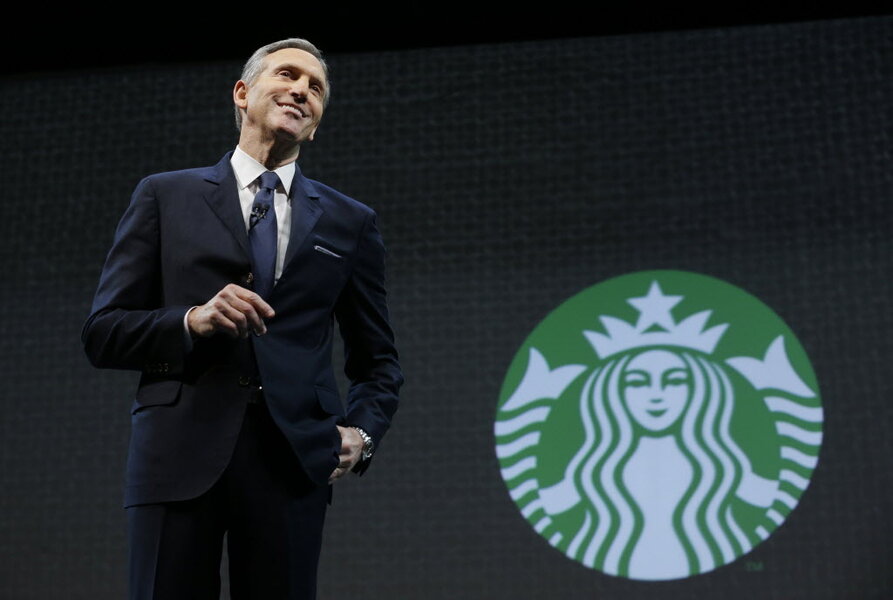Starbucks leads initiative to hire 100,000 'disconnected' Millennials
Loading...
An estimated 5.6 million young people between the ages of 16 and 24 are currently unemployed and out of school in the United States, and now several big names in the private sector are stepping in to get them to work.
On Monday, Starbucks, Target, Walmart, Macy’s, and thirteen other US-based companies announced their plan to provide jobs, internships, and apprenticeships for 100,000 young people who “face systemic barriers” to these types of opportunities. The initiative will be spearheaded by a $30 million investment from Starbucks CEO Howard Schultz through the Shultz Family Foundation.
“We approach this problem through the lens of our own experiences. Howard grew up in public housing in Brooklyn, where he watched his father struggle to support his family. Sheri grew up in a middle-class family in Lima, Ohio, where her father helped those who were less fortunate,” Mr. Schultz and his wife Sheri Shultz wrote in an Op-Ed for the New York Times.
“We have both known countless individuals who grew up without role models or even a basic education. We have seen what is possible when these people are given a chance to succeed.”
While at first glance the initiative may appear to be another philanthropic endeavor among a string of attempts by the non-profit sector to assist those who have been named the “disconnected youth” or “opportunity youth”, it is the first coordinated effort on the part of employers to address the issue through hiring. Experts have frequently pointed out that there is a gap between the hiring needs of employers and the skills of “opportunity youth”, and now a handful of private businesses are stepping in to bridge that gap themselves. But in order for the initiative to provide a permanent solution for these young people, it will need to prepare them to meet the real demands of the labor market, experts say.
For this to be sustainable over the long term, it needs to meet the labor force needs of employers, and not only be a corporate philanthropic initiative," Martha Ross, a Brookings Institution scholar who studied youth unemployment, told the Washington Post.
"Improving the employment status of young adults and helping employers meet their workforce needs can be complementary goals, but initiatives need to be carefully structured to address the dynamics of both the supply and demand sides of the labor market."
While the results of the initiative remain to be seen, those leading the operation say they plan to do just that.
During the initiative’s launch, the Aspen Institute’s Forum for Community Solutions will act as an intermediary between the targeted young people and the companies ready to hire them by building on the work of its Opportunity Youth Incentive Fund (OYIF), which was launched 2012 to provide support for “opportunity youth” in 21 communities throughout the country. The Aspen Institute says it will provide “direct leadership, technical assistance, and programmatic support” to launch the new private sector initiative in a handful of the cities where the OYIF was already working.
The first push will take place in the form of an "opportunities fair" in Chicago. The companies participating in the fair have said they expect to train more than 2,000 young people during the event on August 13 and make at least 200 on-the-spot job offers.
“We picked Chicago because it has a strong system of support from local community organizations and the local government, says Daniel Pitasky, the Schultz Family Foundation Executive Director. "So it’s a combination of bringing committed business partners and having a strong system of care that exists that can finish the equation. These systems touch a significant number of young people in Chicago. Chicago has one of the largest public school systems in the country, so there are a lot of kids to plug into this."
Companies as diverse as Taco Bell and Hilton have expressed their commitment to providing “opportunity youth” with a chance to get their feet in the door of the job market and gain that much-needed first employment experience.
Still, some questions remain about how the hiring of these young people will be prioritized and whether they will displace other, more experienced candidates looking for work. Shultz, however, has stressed that existing jobs will not be displaced, and that the new opportunities will come through the creation of entry-level positions, and through the replacement of workers leaving the company.
Meanwhile, supporters say they hope more companies will join the effort.
“In America, your ZIP code should never determine your destiny. Breaking down barriers to employment for young people doesn’t just help the individual workers – it benefits entire communities and the economy at large,” US Secretary of Labor Thomas E. Perez said in a statement. “The corporate leaders championing the 100,000 Opportunities Initiative recognize that promoting career opportunities for youth is a win-win, and I hope more employers will follow their lead.”
Job creation, and ways to extend advancement opportunities to a wider array of workers, have been on Schultz’s radar for awhile. In 2011 Starbucks paired up with community financial institutions on a program called “Create Jobs for USA,” through which donations from Starbucks customers and employees were collected to fund community business lending. In 2013, Starbucks also pledged to hire at least 10,000 military veterans by 2018.
“A lot of young people with extensive barriers have a lot of potential and don’t have the opportunity to achieve their dreams. But we see them as enormous assets to the labor market and the nation. They aren’t the biggest challenges, they are the biggest assets,” says Mr. Pitasky.
“They have the grit and determination, they represent America’s future. But training young people doesn’t help if there aren’t any opportunities. The private sector can be a catalyst in this.”








